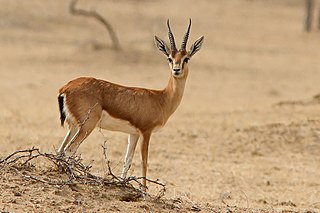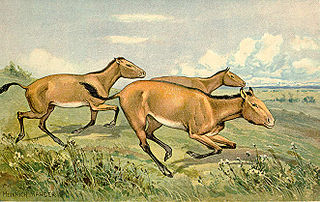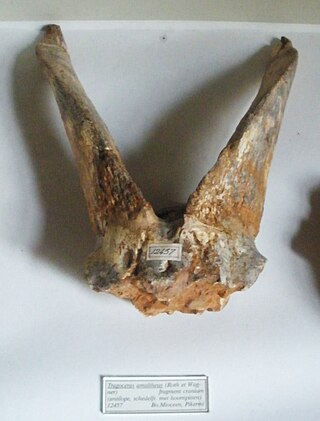
The subfamily Caprinae, also sometimes referred to as the tribe Caprini, is part of the ruminant family Bovidae, and consists of mostly medium-sized bovids. A member of this subfamily is called a caprine.

The Bovidae comprise the biological family of cloven-hoofed, ruminant mammals that includes cattle, bison, buffalo, antelopes, sheep and goats. A member of this family is called a bovid. With 143 extant species and 300 known extinct species, the family Bovidae consists of 11 major subfamilies and thirteen major tribes. The family evolved 20 million years ago, in the early Miocene.

The four-horned antelope, also called chousingha, is a small bovid antelope native to central, South and Western India, along with a smaller population in Nepal. The sole member of the genus Tetracerus, the chousingha was first described in 1816 by French zoologist Henri Marie Ducrotay de Blainville. Three regional subspecies are currently recognised. The four-horned antelope has a yellowish-tan, sometimes reddish or goldenrod coat. It is slender with thin legs and a short tail. It stands nearly 55–64 cm (22–25 in) at the shoulder and weighs about 17–22 kg (37–49 lb). Its four horns are unique among antelopes and distinguish it from most other bovids. The longer pair of straight, spike-like horns is atop its head between the ears, while the other, shorter pair is on the forehead; its posterior horns are always longer than the anterior horns, which may even present as merely fur-covered "studs". While the posterior horns measure 8–12 cm (3.1–4.7 in), the anterior ones are usually 2–5 cm (0.79–1.97 in) long.

Antilope is a genus of twisted-horn bovid that contains a single living species, the blackbuck of South Asia. Two extinct species are also known.

The Antilocapridae are a family of ruminant artiodactyls endemic to North America. Their closest extant relatives are the giraffids. Only one species, the pronghorn, is living today; all other members of the family are extinct. The living pronghorn is a small ruminant mammal resembling an antelope.

A gazelle is one of many antelope species in the genus Gazella. There are also seven species included in two further genera; Eudorcas and Nanger, which were formerly considered subgenera of Gazella. A third former subgenus, Procapra, includes three living species of Asian gazelles.

The Vallesian age is a period of geologic time within the Miocene used more specifically with European Land Mammal Ages. It precedes the Turolian age and follows the Astaracian age. The so-called Vallesian Crisis resulted in the extinction of several mammalian taxa characteristic of the Middle Miocene.

The Orleanian age is a period of geologic time, within the Miocene and used more specifically with European Land Mammal Ages. It precedes the Astaracian age and follows the Agenian age.
In biostratigraphy, MN 4 is one of the MN zones used to characterize the fossil mammal faunas of the Neogene of Europe. It is preceded by MN 3 and followed by MN 5; together, these three zones form the Orleanian age of the middle Miocene. This zone starts within magnetostratigraphic chron C5Dr, at 18 million years ago, and ends within chron C5Cr, at 17.0 million years ago, although some different correlations have been proposed.

Nyanzachoerus is an extinct genus of the pig family (Suidae) belonging to the subfamily Tetraconodontinae. The several species of Nyanzachoerus lived in Africa from the Miocene to Pliocene.

Ouranopithecus macedoniensis is a prehistoric species of Ouranopithecus from the Late Miocene of Greece. See more detail at Ouranopithecus.

Enhydriodon is an extinct genus of mustelids known from Africa, Pakistan, and India that lived from the late Miocene to the early Pleistocene. It contains nine confirmed species, two debated species, and at least a few other undescribed species from Africa. The genus belongs to the tribe Enhydriodontini in the otter subfamily Lutrinae. Enhydriodon means "otter tooth" in Ancient Greek and is a reference to its dentition rather than to the Enhydra genus, which includes the modern sea otter and its two prehistoric relatives.

Goat evolution is the process by which domestic goats came to exist through evolution by natural selection. Wild goats — medium-sized mammals which are found in noticeably harsh environments, particularly forests and mountains, in the Middle East and Central Asia — were one of the first species domesticated by modern humans, with the date of domestication generally considered to be 8,000 BC. Goats are part of the family Bovidae, a broad and populous group which includes a variety of ruminants such as bison, cows and sheep. Bovids all share many traits, such as hooves and a herbivorous diet and all males, along with many females, have horns. Bovids began to diverge from deer and giraffids during the early Miocene epoch. The subfamily Caprinae, which includes goats, ibex and sheep, are considered to have diverged from the rest of Bovidae as early as the late Miocene, with the group reaching its greatest diversity in the ice ages.
Hispanomeryx is an extinct genus of artiodactyl from the middle to late Miocene epoch, living from 13 to 8 million years ago. Over the years, they have been variously classified as being related to bovids or giraffes, or even belonging to their own unique family, but they are now widely regarded as moschids, relatives of the living musk deer.

Tragoportax is an extinct genus of bovid ungulate. It lived during the upper Miocene, and its fossils have been found in Europe, Asia and Africa. Tragoportax is sometimes considered to have been a close relative of the extant nilgai, though it may have formed its own subfamily, along with Miotragocerus.
Prostrepsiceros was a genus of bovid from the Miocene epoch.
Sporadotragus was a genus of caprine bovid that inhabited Eurasia during the Miocene epoch.
Turcocerus is an extinct genus of caprine bovid that lived in Eurasia during the Neogene period.
Urmiatherium is an extinct genus of caprine bovid that inhabited Eurasia during the Neogene period.
The KızılırmakFormation is a geological formation located in Turkey that contains fossils from the Late Oligocene Suevian and Arvernian. It is part of the lower Çankırı-Çorum Basin, overlying the Güvendik Formation and underlying the Kilçak Formation.













